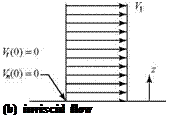Boundary Conditions
Before further discussion of aerodynamic problem solving, it is important to realize that problem formulation requires a careful mathematical statement of the boundary conditions in addition to the set of governing differential equations that occupies much of our attention in this chapter. This section is a brief discussion of
 |
 |
Figure 3.5. Wall boundary conditions for viscous and inviscid-flow models.
key features of aerodynamic boundary conditions, which must always be considered when applying the equations in particular applications.
The set of defining equations that must be solved is the same for many diverse problems in aerodynamics. The mathematical solution that correctly describes a specific problem is obtained by applying the appropriate boundary conditions. Boundary conditions represent physical constraints that the solution must obey; they usually involve the physical behavior of the flow and the particular geometry of the problem.
As observed in subsequent chapters, a primary boundary condition is one that specifies what the flow must do at the surface of an object in the flow or on surfaces bounding the flow field. In a viscous-flow model, the boundary condition is that there is no slip at the surface—that is, the viscous flow adheres to the surface (see Chapter 2), so that both the normal and the tangential velocity components are zero at the surface. Of course, the normal velocity may not be zero if the surface is porous with fluid entering the region of interest through the boundary.
In an inviscid-flow model, only the tangency boundary condition can be invoked, which states that the flow must be everywhere parallel to the body surface or, equivalently, that there can be no velocity component perpendicular to a solid surface. Thus, in the inviscid-flow model, the normal component of velocity is zero at the surface but the tangential component is not! These two situations are contrasted in Fig. 3.5. Other types of boundary conditions may be encountered—for example, if mass transfer through a porous body surface forms part of the flow-field boundary.











